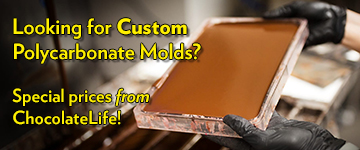depends on your scale - most are adjustable to read whatever the local norm is. i find it easiest to work in grams.
Need Help Calculating Volume of Chocolate For Mold Cavity
Thanks Sebastian.
That helps a lot. If you are using ml for volume, then what is the scale for mass? Grams? Ounces?
ah - well, if you've got the exact measurements, determining the volume is trivial. Your chocolate supplier isn't likely to have the densities for all their chocolates measured, and you can ask them to do it, which they will if they have time, or they'll make time if you're a large enough customer. If precision is important to you, remember that specifications have a range (ie fat is normally +/-1% on industrial chocolates) - so that range will result in a range of densities as well.
If you want to do the density yourself, you'll need a graduated cylinder and a scale - density is simply mass over volume - so fill your cylinder (on the scale) to 100ml of chocolate and read it's mass. D = m/v. The reading on the scale divided by 100 (the mls you used for the reading), and you've got a density calculation. Obviously if your scale is not calibrated, if you're not accurate in filling the cylinder, or if your chocolate temps are all over the place, it will impact your calculations.
Once you've got your volume of your cavity - simply multiply that by your density, and you've got the grams/unit of measure. Be sure not to mix your units of measure between your cavity volume calculations and density calculations (ie don't use both inches and centimeters, for example - one or the other)
Hi Sebastian. Thanks for the response. Perhaps I should give you a bit more info about my situation, so it makes more sense. I am actually manufacturing my own molds. I will always know the exact dimensions of my molds every time. So like Clay said is actually really trivial. I just need the densities of the chocolate I plan to use, and figure out the formula to calculate the mold volume and density (I'm suspecting that it's something like: w*h*d*Density etc. Yes, I can approximate with a cubic inch (like using the chocoley calculator), but since I have access to the exact measurements (perhaps I'm completely off base), it seems to me I can get much more accurate results by doing the math. I apologize to anyone if my responses sound stubborn or like I'm taking the wrong path. It just seems to me if I have my mold dimensions, and I can get the densities I can get relatively close estimations of my needs (especially on large scales) by doing some math, and perhaps as a result save money on my chocolate needs etc.
Thanks again for the feedback guys. I really do appreciate it.
I honestly think you're taking the path of most resistance, mate..now, even though i've had as many calc classes as they offer, i'm not a math guy, and for most moulds, mathematically calculating the volume's going to be an incredibly tedious process. If you must know the cubic inches of the mould, the mfr should be able to provide that, as their molds are made using design software that should be able to provide the volumetric with a click of a button. That's what i'd do, but the scale i work at is perhaps a little different than most 8-)
Hey Clay. Thanks much for the response. Yes it's a single test mold. For this purpose, I went ahead and did a few molds (thankfully I had a little Guittard chocolate on hand), and weighed each piece. I then scaled my mold size up/down based upon the chocolate weight. So for my immediate need that worked. Not my preference of course, but I think it worked. I know you guys prefer to measure with chocolate rather than a calculator, and I totally understand that, but I would also like to have the capacity to calculate with a calculator to get close measurements. I can easily get my mold dimensions so that isn't a problem. I'll contact Guittard and see if I can get the densities of their chocolate.
Clay: Can you give me a formula that would calculate the mold capacity using volume and chocolate density? How would you put that together? (w*h*d = volume +*/- density?
Thanks again guys. 
Brian -
Actually, I think the empirical way to arrive at the solution is the elegant one. The challenge you face is that you don't own the mold - a single-cavity prototype? - so doing the work is a little cumbersome.
You could come up with a mathematically precise answer, but to do so you'd need to know the exact volume of the mold (non-trivial) and need the densities of each chocolate at the temperature you're using for each mold (contact Guittard for this information - but I don't know that they have it handy). You could end up with a different weight of chocolate - probably within a percent or so - for each chocolate you use. Precise but inelegant - and maybe more work than doing it empirically.
Plus, I have to agree with Sebastian - I find working with chocolate a lot more fun than working with calculators.
--
~~~~~~~~~~~~~~~~~~~~~~~~~~~~~~~~~~~~~~~~~~~~~~
@DiscoverChoc
Thank you so much for the responses. Unfortunately, I don't have that mold in my possession, so I was hoping for a way to closely/accurately measure the chocolate needed to fill the cavity. Thanks for the clarification on Chocoley's calculator. That makes sense. I do have some Guittard chocolate in possession, but don't have a simple way to calculate a cubic inch of the Guittard chocolate.
I do have a smaller version of the same mold however (only one cavity though), so I guess I'll have to fill that one, then weight it, then figure out how many get me a pound..I was hoping for a more elegant solution, but I guess that will have to do.
Thanks again guys.
Actually, volume doesn't care about density. Ounces is a measure of mass - volume is a measure of space. His question was about volume; but i suspect he's really asking about mass 8-)
If you're looking to measure the mass / cavity so you can better estimate how much chocolate you'll need to order, probably the most simple way to approach it, assuming you have said mold, is to mold up a form of chocolate using it, weigh the 20 pieces that come out of it, and determine the average weight per piece. Don't forget to add in an overage to compensate for waste/working mass. That way you don't need to compensate for the subtleties of temperatures impact on volume/density and complexities of volumetric calculations of irregular cavity shape.
Plus everyone knows that making chocolate is more fun than doing math 8-)
Chocoley's formula basically states that 0.708 ounces of chocolate will fill 1 cubic inch and the mold is a perfect cuboid. Of course some chocolate is going to be more dense than others and I have yet to see a mold that is a perfect solid shape (e.g. without bevels, curves, patterns, etc.) so this formula is only intended to get you in the ballpark. You can get a little more accurate if you can figure out how many ounces a cubic inch of Guittard chocolate weighs and substitute 0.708 with this value.
Hi All,
I'm trying to calculate the volume of chocolate for a mold with the following dimensions:
1.80x1.21x0.58
I used the following website's chocolate calculator to calculate the volume:
http://www.chocoley.com/chocolate-candy-making-guide/how-much-chocolate-per-mold.htm
Is this accurate for all chocolate or just theirs? If it just works for theirs, I need to calculate for Guittard chocolate.
Any help would be greatly appreciated.
updated by @brian-begun: 04/11/25 09:27:36
Tags
Activity
Chocolatevenue is an online chocolate store in India.We are specialized in customized chocolates .Chocolates can be customized as chocolate message and chocolate bars.
You can get written your message on chocolates and can get customized your chocolate bars by selecting the desired ingredients.
for more details
FOR SALE / BARGAIN / FINE CACAO LIQUOR, COLOMBIA ORIGIN
Enjoy a delicious premium chocolate from the Boyacá region of Colombia, considered among the best in the world. We offer a 200 kilograms lot of pure origin cocoa liquor, fair trade / ethically sourced. N o other ingredients added.
The price for this high quality product is as follows:
1 kg - US$ 13
100 kg - US$ 12 per kilo
200 kg - US$ 11 per kilo
Inquires: equalcolombia@gmail.com
- See more at: https://www.thechocolatelife.com/colorchocolate#sthash.JFDWYFuK.dpuf
- See more at: https://www.thechocolatelife.com/community/forums/my_posts/18453/fine-cacao-liquor-colombia-origin#sthash.2pUq4Eu3.dpuf
The headline says it all: United Cacao: the sad tale of when things really go wrong for Aim investors .
Two changes we made with the chocolate is that this time we winnowed the chocolate. This time we didn't use a blow dryer to melt the chocolate. Two improvements with the chocolate is that the melanger didn't get clogged this time and everyone put in work.

